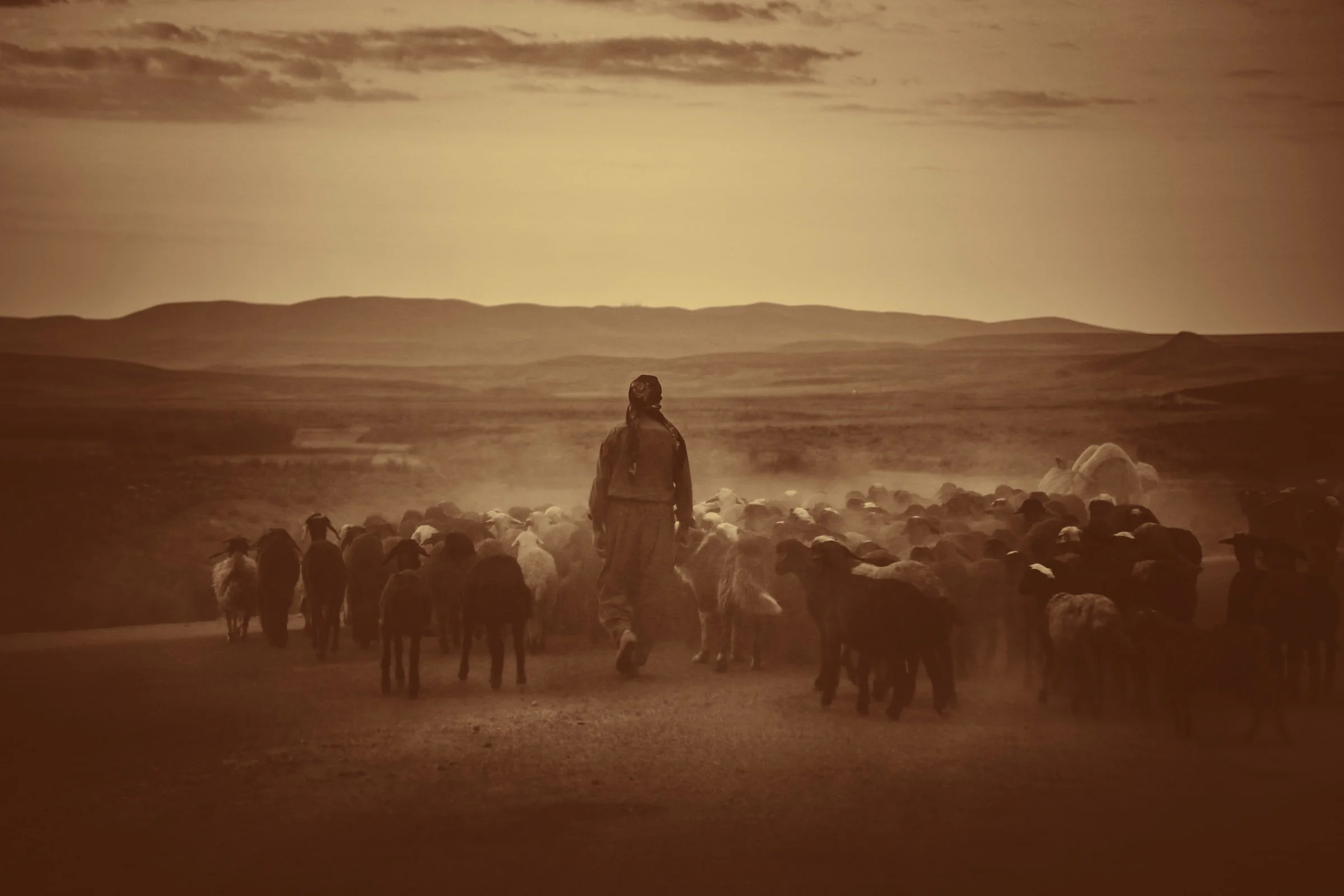In Numbers 10, Israel finally set out from the foot of Mount Sinai. They had been there since the exodus from Egypt, and it was there they received the Ten Commandments. Before leaving Sinai, Moses asked a man named Hobab to come with them on their journey to the Promised Land, particularly because he could guide Israel in the wilderness. Moses said, “Please do not leave us, for you know where we should camp in the wilderness, and you will serve as eyes for us” (Numbers 10:31). Here is the entire passage:
29 And Moses said to Hobab the son of Reuel the Midianite, Moses’ father-in-law [חֹתֵ֣ן], “We are setting out for the place of which the Lord said, ‘I will give it to you.’ Come with us, and we will do good to you, for the Lord has promised good to Israel.” 30 But he said to him, “I will not go. I will depart to my own land and to my kindred.” 31 And he said, “Please do not leave us, for you know where we should camp in the wilderness, and you will serve as eyes for us. 32 And if you do go with us, whatever good the Lord will do to us, the same will we do to you.” (Numbers 10:29-32, ESV)
The text says Hobab wanted to depart to his own land (10:30), but it is unclear whether Moses was able to persuade him to stay with his appeal that Hobab would be useful for Israel and that he would be blessed by the Lord in coming (10:31-32). However, the passages of Judges 1:16 and 4:11 show that Hobab’s descendants eventually did end up in the land Canaan. These verses suggest that Hobab changed his mind and did in fact go with Moses and Israel into Canaan:
And the descendants of the Kenite, Moses’ father-in-law [חֹתֵ֣ן], went up with the people of Judah from the city of palms into the wilderness of Judah, which lies in the Negeb near Arad, and they went and settled with the people. (Judges 1:16)
Now Heber the Kenite had separated from the Kenites, the descendants of Hobab the father-in-law [חֹתֵ֣ן] of Moses, and had pitched his tent as far away as the oak in Zaanannim, which is near Kedesh. (Judges 4:11)
Was Hobab Moses’ Father-in-Law?
However, when these passages are compared, they raise the question of Hobab’s identity. The Hebrew text of Numbers 10:29 says Hobab was “the son of Reuel the Midianite, Moses’ father-in-law.” Thus, according to Numbers 10:29, Hobab was the son (or son-in-law) of Moses’ father-in-law Reuel (father of Zipporah, Moses’ wife). Another name for Reuel is Jethro, the priest of Midian, seen from the text of Exodus 2–3 (Exodus 2:18; 3:1).
So far, so good. But a problem is raised by Judges 4:11, which refers to “Hobab the father-in-law [חֹתֵ֣ן] of Moses.” This seems to contradict Numbers 10:29:
to Hobab the son of Reuel the Midianite, Moses’ father-in-law (Numbers 10:29)
לְחֹבָב בֶּן־רְעוּאֵ֣ל הַמִּדְיָנִי֮ חֹתֵ֣ן מֹשֶׁה֒
the Kenites, the descendants of Hobab the father-in-law of Moses (Judges 4:11)
מִקַּ֔יִן מִבְּנֵ֥י חֹבָ֖ב חֹתֵ֣ן מֹשֶׁ֑ה
Numbers 10:29 calls Reuel Moses’ choten (חֹתֵ֣ן), while Judges 4:11 calls Hobab Moses’ choten. And the word choten is usually translated in English translations as “father-in-law.” One proposed solution is that Hobab is a third name for Jethro and Reuel. However, there are several reasons to reject this solution. First, Numbers 10:29 calls Hobab the “son” of Reuel. Second, Judges 4:11 indicates the Kenites were descended from Hobab, and Judges 1:16 likely refers to Hobab as a “Kenite,” which seems to conflict with the description of Jethro/Reuel as a Midianite (Exodus 3:1; 18:1). It makes more sense that Hobab was either the son-in-law of Jethro/Reuel (and thus of different blood) or that Hobab was the son of Jethro/Reuel but was known as a Kenite and not a Midianite (though the two were related). Third, Exodus 18:27 indicates that Reuel/Jethro had already departed Israel in the wilderness prior to Numbers 10:29.
The Hebrew choten (חֹתֵ֣ן)
Therefore, it does not make sense that Hobab was the same person as Jethro/Reuel. Rather, it makes good sense that Hobab was the “son” of Reuel (Jethro) as Numbers 10:29 says. So what then do we do with the apparent contradiction in Judges 4:11?
The solution seems to be in how we understand the Hebrew word choten (חֹתֵ֣ן). While most English versions translate it as “father-in-law,” there is good reason to think it has the broader meaning of any “relative” by marriage,” or “in-law” as we say in English. In this case, the same word choten could be used both for Moses’ brother-in-law (Hobab) and Moses’ father-in-law (Reuel/Jethro). They were both relatives by marriage. Thus, Judges 4:11 refers to Hobab as the “brother-in-law” of Moses, not “father-in-law.” And since Judges 1:16 seems to refer to Hobab as the “Kenite,” it also uses choten as “brother-in-law.”
This solution was proposed by T. C. Mitchell in his 1969 article, “The Meaning of the Noun htn in the Old Testament” (Vetus Testamentum 19 [1969]: 93–112). Mitchell suggested the meaning of “relation-by-marriage” for choten (105). He noted the group of Hebrew words related to choten refer to relatives by marriage. This includes the noun chatan (חָתָן), which has the same letters in Hebrew as choten (חֹתֵ֣ן) but is pointed differently by the Masoretes and means “son-in-law” (Genesis 19:14, Judges 19:5; 1 Samuel 18:18, and 1 Samuel 22:14).
This conclusion is also followed by Robert H. O’Connell in the New International Dictionary of Old Testament Theology and Exegesis (2:318–321), who says that in Judges 4:11,
where Hobab is identified as “the חֹתֵן of Moses,” חֹתֵן could mean either father-in-law or brother-in-law (cf. BDB, 368b); indeed, other derivatives of the root חָתַן show that a fraternal sense brother-in-law, male-relative-by-marriage is possible.
These other derivatives of choten include (1) the verb to “intermarry” (Deuteronomy 7:3; Joshua 23:12; Ezra 9:14), (2) the word chatan (חָתָן) for “son-in-law” (Judges 15:6; 19:5) or “bridegroom” (Psalm 19:5 [19:6, MT]; Jeremiah 7:34), and (3) chatunna (חֲתֻנָּה) for “marriage” (Song of Songs 3:11). In support of the translation of “brother-in-law” for choten in Judges 4:11, O’Connell also notes Josephus (Antiquities of the Jews 2:12:1), the Vulgate, and Theodotion’s Greek version of the OT.
This broader understanding of choten in Judges 4:11 was used by Jerome in his Latin Vulgate translation, as he translated choten as “relative” (cognatus) in all three passages (Numbers 10:29; Judges 1:16; 4:11). Among modern translations, the NIV translates Judges 4:11 as “brother-in-law” (though it inconsistently translates Judges 1:16 as “father-in-law).
Conclusion
A broader understanding of choten as a relative by marriage in Judges 1:16 and 4:11 helps make sense of Numbers 10:29. If this is correct, then Hobab was in fact the “son” of Reuel/Jethro as Numbers 10:29 says, though this could also mean he was a “son-in-law” in that he was married to one of Reuel’s seven daughters (Exodus 2:16). Hobab was not Jethro but rather Moses’ brother-in-law. This meaning would be expressed in the following translations:
to Hobab the son of Reuel the Midianite, Moses’ father-in-law (Numbers 10:29)
And the sons of the Kenite, Moses’ brother-in-law (Judges 1:16)
the Kenites, the sons of Hobab, Moses’ brother-in-law (Judges 4:11)


